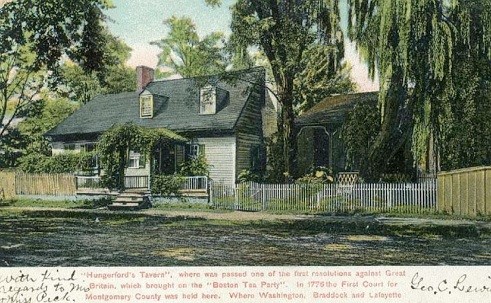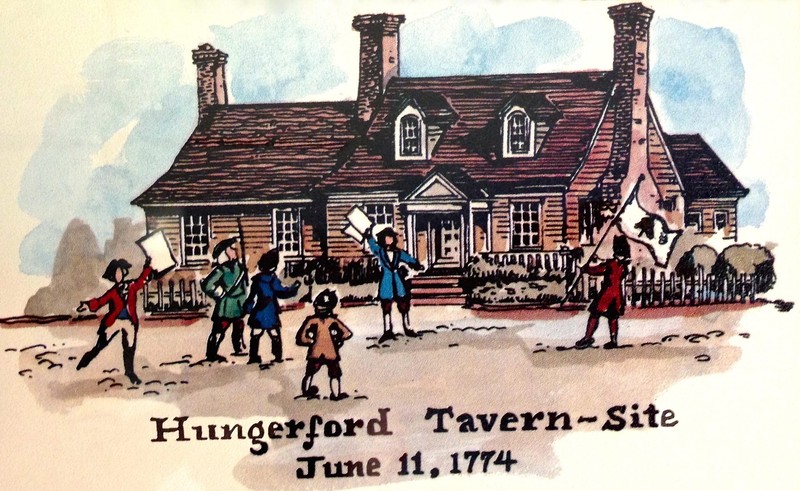Hungerford Tavern Historical Marker and the Hangerford Resolves (1774)
Introduction
Text-to-speech Audio
Images
Postcard depicting the Tavern from around 1910. The caption goes on to list the amount of famous revolutionary figures who have stayed there.

"Hungerford Tavern Site - Rockville, Maryland" by Carol Stuart Watson. The artist depicts the scene surrounding the Hungerford Tavern just after the Hungerford Resolves are announced.

Backstory and Context
Text-to-speech Audio
Built as a one and a half story house by Joseph Wilson in 1753, by 1755 this building had become a tavern known as Owen’s Ordinary. The road that the tavern was situated on was well traveled and connected several sections of the Maryland colony. For example, British General Braddock and his Aide-de-camp George Washington camped outside Owen's Ordinary in the spring of 1755 while on their march to assault Fort Duquesne.
By 1770, Charles Hungerford had acquired Owen’s Ordinary and the business became known as the Hungerford Tavern. On June 11th 1774, a group of landowners met to discuss what became known as the Intolerable Acts- the taxes Great Britain laid on the colonies. These men also expressed their support for the Sons of Liberty after the Boston Tea Party. After much deliberation, these men wrote down five declaratory statements that became known as the Hungerford Resolves.
Resolved, unanimously, That It is the opinion of this meeting that the Town of Boston is now suffering in the Common Cause of America.
Resolved, unanimously, That every legal and constitutional measure ought to be used by all America for procuring a repeal of the Act of Parliament for blocking up the Harbour of Boston.
Resolved, unanimously, That it is the opinion of this meeting that the most effectual means for the securing of American Freedom will be to break off all Commerce with Great Britain and the West Indies until the said act be repealed and the right of taxation given upon permanent principles.
Resolved, unanimously, That Mr. Henry Griffith, Dr. Thomas Sprigg Wootton, Nathan Magruder, Even Thomas, Richard Brooke, Richard Thomas, Zadok Magruder, Dr. William Baker, Thomas Cramphin Jr., and Allen Bowie be a committee to attend the general committee at Annapolis, and that any six of them shall have the power to receive and communicate intelligence to and from their neighboring committees.
Resolved, unanimously, That a copy of these our sentiments be immediately transmitted to Annapolis and inserted in the Maryland Gazette.
At Hungerford’s Tavern,
11th June, 1774
Signed per Order,
Archibald Orme, Clerk5
These declarations were far more radical than the negotiated declarations of the Annapolis Convention of 1774. It is also significant that this document did not mention the Maryland Colony, but rather “The Common Cause of America.”
In 1776 at the Maryland Constitutional Convention, Thomas S. Wootton proposed to divide up the large Frederick County into multiple smaller counties. The measure passed and by 1777 the Hungerford Tavern became Montgomery County’s courthouse, polling place, and a small jailhouse built on for runaway slaves.
On 13 August 1777, Hungerford went to court and guaranteed for Leonard Davis to take over the license of the tavern. By 1780, Hungerford had been elected Justice of the Peace for Montgomery County and was a member of the Lower House. The tavern was bought and sold numerous times over the years and by 1847 was bought by Susan Russell whose father Joseph Wilson built the structure almost 100 years earlier. In 1911 the DC Chapter of the Daughters of the American Revolution attempted to buy the Russell House, but were unable to find incontrovertible evidence that the house was the same as the tavern. By the time public interest grew it was too late and the house was razed to build a new Baptist church. The site of the tavern is now occupied by a branch of BB&T Bank.
Sources
2. Three Firms Film LLC. Colonial Era. Three Firms Film LLC. . Accessed June 20, 2018. http://www.threefernsfilms.com/Luxmanor/Luxmanor_History/Colonial_Era.html.
3. Rockville's Pike Plan Planning Commission. Appendix B: Rockville Pike History. Rockville's Pike Plan Planning Commission. . Accessed June 20, 2018. http://www.rockvillemd.gov/DocumentCenter/View/15238.
4. Papenfuse, Edward C. A Biographical dictionary of the Maryland Legislature, 1635-1789. Baltimore, MD. Johns Hopkins Publishing, 1979. P. 472
5. Scharf A.M., J. Thomas. History of Western Maryland. Vol. Vol. I.. Philadelphia, Pennsylvania. 1882. P. 124
6. Maryland State Archives. Montgomery County. Maryland In Focus. . Accessed June 20, 2018. https://msa.maryland.gov/msa/speccol/photos/lowe/html/mo_2.html.
7. Scharf A.M., J. Thomas. History of Western Maryland. Vol. Vol. I.. Philadelphia, Pennsylvania. 1882. P. 658
8. Papenfuse, Edward C. A Biographical dictionary of the Maryland Legislature, 1635-1789. Baltimore, MD. Johns Hopkins Publishing, 1979. P. 472
9. Kelderman, Eric. "The Search for Hungerford's Tavern." The Gazette August 29, 2001.
Rockville's Pike Plan Planning Commission. Appendix B: Rockville Pike History. Rockville's Pike Plan Planning Commission. . Accessed June 20, 2018. http://www.rockvillemd.gov/DocumentCenter/View/15238.
Kelly, John. "Answer Man Dispenses a Dram of Md. History." Washington Post(Washington DC)September 17, 2006. , Metro sec.
10. Kelderman, Eric. "The Search for Hungerford's Tavern." The Gazette August 29, 2001.
